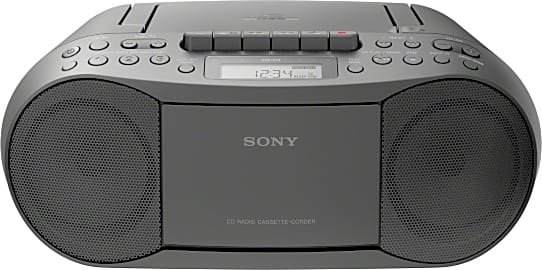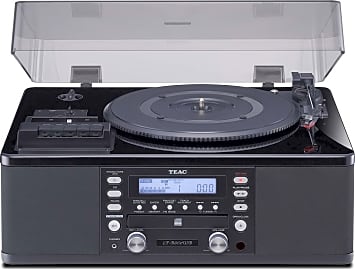The 10 Best Cassette Players

This wiki has been updated 34 times since it was first published in October of 2016. You know the mix tapes you used to record, or the music collection that is gathering dust in the attic because you've gone digital? Well, without investing a lot of money, you can pick up one of these cassette players and bring those old songs back to life. We've made our selections based on features and overall value, so you're sure to find something that meets your needs and budget. When users buy our independently chosen editorial choices, we may earn commissions to help fund the Wiki.
Editor's Notes
October 09, 2020:
If you want a pocket-sized model that will allow you to listen to your cassette collection on the go, you'll want to check out the Jensen Retro, Reshow Cassette, and Byron Statics Portable. In addition to being compact these selections are generally the most inexpensive type of player you can get, so they're also a good choice for those who are trying to spend as little as they can. In regards to unique features between the three, note that the Reshow Cassette doubles as a digitizer, the Byron Statics Portable is one of the most affordable choices on the market, and the Jensen Retro has a slightly superior build-quality and button-feel.
If audio fidelity is your primary concern rather than price or portability, your best bet is definitely going to be traditionally designed decks such as the Teac W-1200, Pyle Dual, and Teac Home Theater Receiver. Unfortunately, no new cassette players these days feature super high-quality tape transports since no one makes them anymore, but the superiority of all the other components these machines use, along with an abundance of advanced features, definitely gives them an edge in terms of sound quality and versatility compared to other new players. These options all feature USB outputs, making them a viable solution for creating high-quality cassette transfers as well. Analog music enthusiasts may particularly take a liking to the Teac Home Theater Receiver since it doubles as a record player.
Those looking for something between a dual deck and a Walkman-style device, you may want to consider boombox-type selections such as the Sony Boombox, Naxa NPB-268, Victrola Classic, Riptunes Wireless. These models all have the ability to run on batteries and are relatively portable, but they're also perfectly adequate for stationary use if you're looking to avoid setting up an entire stereo system with a receiver and external speakers. Several of these options are also capable of playing CDs, digital audio files, and even music from your phone, so they themselves can serve as an affordable all in one music player if you don't already have something like a dedicated Bluetooth speaker.
June 27, 2019:
Although it's on the expensive side, we have decided to add the Teac Home Theater Receiver as a top pick. This unit puts your entire music collection right at your fingertips, whether that's vinyl, cassette, or CD. It's also more intuitive to use than some, including the Pyle Dual, although the latter offers two tape decks whereas the former does not. We also still like the Panasonic RQ2102 for those who need to record audio to cassette. It isn't too heavy or burdensome, but you will need to invest in a set of four C batteries, as it doesn't come with any. If your needs are more casual, then the Sony Boombox or Riptunes Wireless might come in handy. They're inexpensive, simple to use, and portable, so you can listen around the home or at the pool or beach. Finally, we decided to remove the Jensen SCR 68Y due to ongoing troubles with the playback quality and overall durability. We also removed the Vtop Digital Life due to availability issues. Consider the similar Geeklin Retro for transferring cassettes to MP3 files while you're on the go.
Special Honors
Tascam 202MKVII The Tascam 202MKVII is a professional-quality dual deck unit with USB output, so if you're looking for something just for playing old tapes from time to time, this probably isn't it. But if you need noise reduction, high-quality recordable mic input, a remote control, and other top-notch features, it may be worth the cost. tascam.com
The Rise And Fall Of The Cassette Tape
The first cassettes were sold blank, but by 1965, pre-recorded tapes were launched in Europe.
The first compact cassettes were designed in Belgium by the Dutch technology company Philips. Brought to market in 1963, the original model was developed for use in dictation machines. The recording potential of the cassette tape was not lost once the format came to be used for music playback. Instead, the cassette tape enjoyed double-marketability for the duration of its widespread use.
Compact cassettes are comprised of two spools that hold a length of magnetic plastic tape between them. This mechanism is contained within a rigid plastic casing with openings at the top to allow the magnetic tape to be read by a receiving mechanism, and features several holes for external components to assist with rotating the spools.
While they were developed as a replacement for reel-to-reel tape cartridges used primarily for professional audio recording, their potential as a widespread audio distribution format was visible right away. Due to industry pressure, Philips allowed other manufacturers to license the format for free, which helped grow its popularity.
The first cassettes were sold blank, but by 1965, pre-recorded tapes were launched in Europe. Under the name music-cassettes, the Mercury Record Company brought the format to the American market in 1966. While initial offerings were limited and audio quality at the time lagged behind the 8-track tape, the cassette business was valued at $150 million by the end of the 1960s.
The rapid growth of the cassette market can be attributed to its convenience. Far more compact than both 8-track tapes and vinyl records, electronics manufacturers were eager to grow the format due to its potential for portability.
The first cassette player for use in car dashboards was introduced in 1968. The audio quality was drastically improved in 1971 by the Advent Corporation, which replaced the standard tape with a commercial-grade version manufactured by 3M and introduced noise-reduction technology into cassette players.
The iconic Sony Walkman arrived in 1979 to great fanfare, and other portable tape players, in both personal and amplified formats, proliferated. Cassette sales overtook those of LPs in the 1980s, though vinyl remained the preferred format for singles until the introduction of the compact disc in the early 1990s. Ultimately, the CD ended up blowing the cassette out of the water, with tape sales sharply declining over the course of the CD's inaugural decade.
While blank cassettes are still widely available, record companies have all but ceased music-cassette production. In 2009, for example, just 34,000 tapes were sold, an astonishingly low figure when compared to the 442 million sold in 1990.
How A Cassette Player Works
For the most part, cassette players have two modes, playback and recording. Both functions rely on the magnetic coating that covers the exposed side of the roll of plastic tape contained within a standard cassette. To understand how a tape player works, it's essential to understand the nature of this magnetic coating.
The coating itself can be made of a variety of magnetic materials, though ferric oxide is among the most popular. While it is permanently magnetized, it carries electromagnetic signals specific to its contents that can be overwritten many times.
It is held in place by a capstan, which also ensures it moves past the play head at a consistent speed, generally 1.875 inches per second.
Standard cassettes contain four electromagnetic signals that run side by side along the full length of the tape. A cassette player only reads two of these signals at a time, as each pair makes up the left and right stereo signals for one side of the tape. When you flip a tape over from side A to side B, the mechanism that reads the tape simply gains access to the other pair of channels.
Both reading and recording take place on the length of tape exposed to the play head built into all cassette players. The exposed tape is stretched flat by a set of guide rollers built into the cassette as well as a pair of spindles typically contained within the player itself. It is held in place by a capstan, which also ensures it moves past the play head at a consistent speed, generally 1.875 inches per second. A soft pressure pad aligned with the opening works to keep the tape taut as it meets with the metal play head.
The tape head contains two small electromagnets that do the work of both playing and recording onto two tracks of the tape at a time, depending on its setting. It can either read the existing right and left-side signals for playback or impart new signals to the magnetic coating. When recording, many cassette players also use a secondary electromagnetic head to erase the existing signals on the tape just before they are re-recorded by the main head.
The Recent Revival Of Analog Listening Formats
While the format is definitely not coming back in full force, there has been a renewed interest in the cassette tape in recent years. As the music industry becomes increasingly digital and buries the compact disc for good, older formats have experienced something of a resurgence. Vinyl sales have increased tenfold over the past decade thanks to a combination of hipster nostalgia and renewed interest in record collecting.
As the music industry becomes increasingly digital and buries the compact disc for good, older formats have experienced something of a resurgence.
The vinyl resurgence has a lot to do with the size and collectability of the format. In the streaming era, it offers fans the opportunity to own a copy of their favorite albums that feels significant when compared to a CD or digital download. A 12-inch square version of the album art looks great on a wall or mantle, allowing die-hard fans to showcase their devotion to their favorite artists.
Unfortunately, cassettes don't make quite the same physical impact, and tape enthusiasts can scarcely hope for a boost of that magnitude. That being said, purchasing physical formats offers fans the opportunity to directly support the artists they love. This is especially valuable when the paltry revenues from streaming take months to actually reach an artist's bank account. Cassette releases in recent years from global superstars like Justin Bieber, Selena Gomez, DJ Khaled, and Lana Del Rey have also helped boost overall sales of the format considerably.















